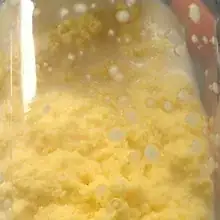Tonight I tried to make some butter from some raw cows milk. I followed the instructions here, and let the cream I skimmed off a gallon of milk sit for about 24 hours to "culture." It didn't really smell "slightly sour" yet, but as I had already gone twice the prescribed time, I decided to move on anyway. I divided the cream between two quart jars, and shook them for about 20 minutes each, as described, and although solid clumps formed in each jar, there was no yellow tint.
So I transferred the contents of each jar into a mixing bowl, and used an electric mixer, per the instructions here, but it made no real difference, except to move the stuff around, so I finished off the batch by straining the butter milk from the solids, rinsing the butter under cool water, and adding a little salt.
The final result looks like this:

In the silver bowl is the finished "butter", in the bowl to the right, the strained off buttermilk, and I'm holding a stick of store-bought butter (Ingredients: Cream, Natural Colors) for color comparison.
This "butter" tastes okay, but doesn't have much of a buttery flavor. It is is also the whitest "butter" I have ever seen. But is it really butter, or did I make something else? To get "normal" yellow butter that tastes butterier, what should I do differently?
